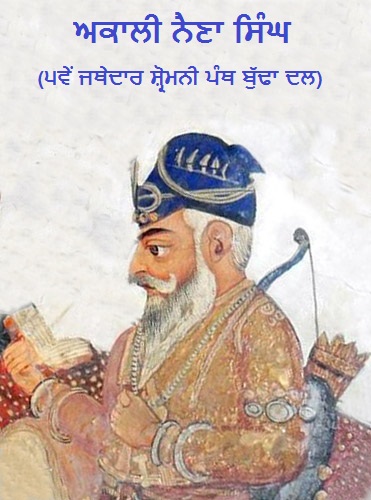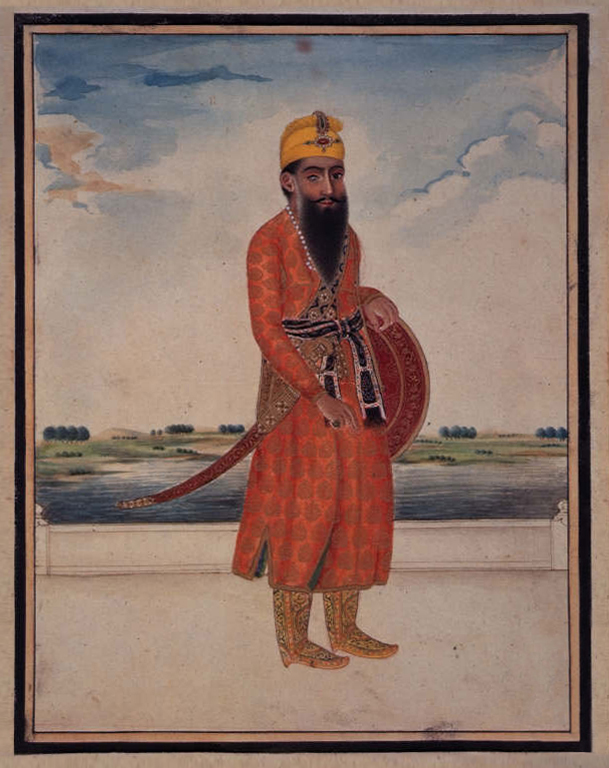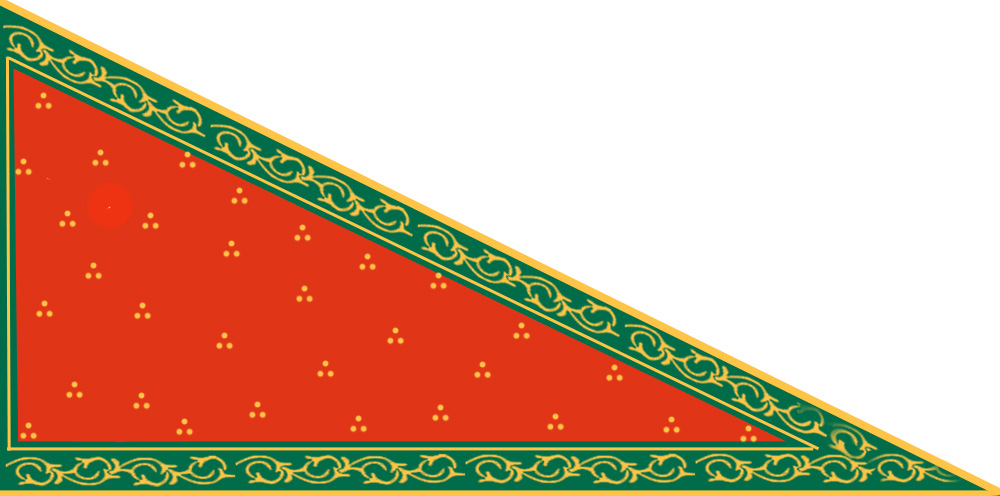|
Akali Phula Singh
Akali Phula Singh Nihang (born Phula Singh; 1 January 1761 – 14 March 1823) was an Akali Nihang Sikh leader. He was a saint soldier of the Khalsa Shaheedan Misl and head of the Budha Dal in the early 19th century. He was also a senior general in the Sikh Khalsa Army and commander of the irregular Nihang of the army. He played a role in uniting Sikh misls in Amritsar. He was not afraid of the British who at many times ordered for his arrest but were not successful. During his later years he served the Sikh Empire as a direct adviser to Maharaja Ranjit Singh. He remained an army general in many famous Sikh battles up until his martyrdom in the battle of Nowshera. He was admired by the local people and had a great influence over the land and his settlement was always open to help the poor and helpless. He was well known and was a humble unique leader and prestigious warrior with high character. He was also known for his effort to maintain the values of ''Gurmat'' and the Khal ... [...More Info...] [...Related Items...] OR: [Wikipedia] [Google] [Baidu] |
Jathedar Of The Akal Takht
The Jathedar of the Akal Takht () is the head of the Akal Takht and head of the Sikhs worldwide. The jathedar has the de facto power as the supreme spokesperson of the Khalsa to Summons, summon, trial, try and sentence (law), sentence any person who identifies as a Sikh from the Akal Takht. The current jathedar, Kuldeep Singh Gargaj, was appointed by the Shiromani Gurdwara Parbandhak Committee (SGPC) on 7 March 2025. Jagtar Singh Hawara, was declared jathedar of the Akal Takht by the Sarbat Khalsa#Sarbat Khalsa 2015, Sarbat Khalsa on 10 November 2015 due to the imprisonment of Hawara, Dhian Singh Mand appointed by the Sarbat Khalsa has been serving as the acting jathedar. The jathedars of the Takht (Sikhism), five takhts generally make important decisions in consultation within the framework of the Sikh Rehat Maryada while considering the collective will of the Sikhs. The position of jathedar is not established by any constitutional document, but exists only by long-established ... [...More Info...] [...Related Items...] OR: [Wikipedia] [Google] [Baidu] |
Nihang
The Nihang (also spelt as Nihung lit. "Crocodiles") or Akali (lit. "Immortals"), also known as '' Dal Khalsa'', is an armed Sikh warrior order originating in the Indian subcontinent. Nihangs are believed to have originated either from Fateh Singh and the attire he wore or from the " Akal Sena" (lit. Army of the Immortal) started by Guru Hargobind. Early Sikh military history was dominated by the Nihang, known for their victories where they were heavily outnumbered. Traditionally known for their bravery and ruthlessness in the battlefield, the Nihang once formed the irregular guerrilla squads of the armed forces of the Sikh Empire, the Sikh Khalsa Army. Etymology The word ''Nihang'' may come from the Persian word for a mythical sea creature (). The term owes its origin to Mughal historians, who compared the ferocity of the Akāli with that of crocodiles. The meaning of Akali in Sikhism however, is the immortal army of Akāl (God). According to Harjinder Singh Dilgeer, trac ... [...More Info...] [...Related Items...] OR: [Wikipedia] [Google] [Baidu] |
Baba Naina Singh
Naina Singh (fl. 18th century), also known as Narayan Singh, was a Nihang warrior and fifth Jathedar of Budha Dal and a chief of the Shaheedan Misl during the late 18th century. Biography Early life Very little is known or can be assured about the early life of Naina Singh. He was born as Narayan Singh around 1736, into a Sidhu Jat family, in Khudi Kurd located in Barnala district. According to Harbans Singh, he must have been alive in or before 1734, the year Baba Darbara Singh passed away, because Naina Singh had received the '' Pahul'' rites under the supervision of Darbara Singh. He was also caretaker of Darbar Sahib. He learned Gurbani and martial skills from Baba Deep Singh. He became associated with the Shaheedan Misl. He joined Budha Dal at the age of 20, along with his nephew Nihang Kharag Singh. Within the Shaheedan Misl, he rose to the ranks of a junior leader headquartered at Damdama Sahib in Talwandi Sabo, located in modern-day Bathinda district. Naina Sing ... [...More Info...] [...Related Items...] OR: [Wikipedia] [Google] [Baidu] |
Munshiram Manoharlal
Munshiram Manoharlal Publishers Pvt. Ltd. (MRML) is a leading publishing house located in New Delhi, India. Established in 1952 by Manohar Lal Jain, it is one of the oldest publishing houses in India. About MRML publishes books on social sciences and humanities and has published over 3000 academic and scholarly publications in Indian art, art history, architecture, archaeology, history, culture, politics, numismatics, geography, travel, voyages, Indian law, Indian medicine, language, literature, linguistics, dictionaries, glossaries, handbooks, indices, music, dance, theatre, religion, philosophy, Buddhism, Hinduism, Islam, Jainism, Sufism, Sikhism, tantra, mysticism, yoga, Sanskrit literature, sociology, anthropology, and related subjects. MRML co-publishes scholarly titles with governmental institutions and bodies such as the Indian Council of Philosophical Research (ICPR); Centre for Studies in Civilizations, which is world-renowned for the series of scholarly publicati ... [...More Info...] [...Related Items...] OR: [Wikipedia] [Google] [Baidu] |
Rowman & Littlefield
Rowman & Littlefield Publishing Group is an American independent academic publishing company founded in 1949. Under several imprints, the company offers scholarly books for the academic market, as well as trade books. The company also owns the book distributing company National Book Network based in Lanham, Maryland. History The current company took shape when the University Press of America acquired Rowman & Littlefield in 1988 and took the Rowman & Littlefield name for the parent company. Since 2013, there has also been an affiliated company based in London called Rowman & Littlefield International. It is editorially independent and publishes only academic books in Philosophy, Politics & International Relations and Cultural Studies. The company sponsors the Rowman & Littlefield Award in Innovative Teaching, the only national teaching award in political science given in the United States. It is awarded annually by the American Political Science Association for people ... [...More Info...] [...Related Items...] OR: [Wikipedia] [Google] [Baidu] |
Jat People
The Jat people (, ), also spelt Jaat and Jatt, are a traditionally agricultural community in Northern India and Pakistan. Originally pastoralists in the lower Indus river-valley of Sindh, many Jats migrated north into the Punjab region in late medieval times, and subsequently into the Delhi Territory, northeastern Rajputana, and the western Gangetic Plain in the 17th and 18th centuries. Quote: "Hiuen Tsang gave the following account of a numerous pastoral-nomadic population in seventh-century Sin-ti (Sind): 'By the side of the river.. f Sind along the flat marshy lowlands for some thousand li, there are several hundreds of thousands very great manyfamilies ..hichgive themselves exclusively to tending cattle and from this derive their livelihood. They have no masters, and whether men or women, have neither rich nor poor.' While they were left unnamed by the Chinese pilgrim, these same people of lower Sind were called Jats' or 'Jats of the wastes' by the Arab geographers. The ... [...More Info...] [...Related Items...] OR: [Wikipedia] [Google] [Baidu] |
Akali Naina Singh Nihang
Akali may refer to: Sikhism In the context of Sikhism, "" ("pertaining to or the Supreme Power", "divine") may refer to: * any member of the , i.e. the collective body of baptized Sikhs * a member of the movement(1919–1925) * a politician of the political parties * a term for the , a Sikh order Other uses * Akali (''League of Legends''), the Rogue Assassin, a playable character in the video game ''League of Legends'' and its associated virtual band K/DA See also * Akala (other) * Akari (other) AKARI (ASTRO-F) was an infrared astronomy satellite developed by Japan Aerospace Exploration Agency, in cooperation with institutes of Europe and Korea. It was launched on 21 February 2006, at 21:28 UTC (06:28, 22 February JST) by M-V rocket ... * Alkali (other) {{disambiguation ... [...More Info...] [...Related Items...] OR: [Wikipedia] [Google] [Baidu] |
Battle Of Nowshera
The Battle of Nowshera (; , ) was fought in Nowshera in March 1823 collectively by the Yusufzai and Khattak tribesmen, supported by the Peshawar sardars, alongside Azim Khan Barakzai, the Afghan governor of Peshawar, where they would face the Sikh armies led by Maharaja Ranjit Singh. Ganda Singh (1986) ''Maharaja Ranjit Singh: First Death Centenary Memorial''. Nirmal Publishers Azim Khan was a half-brother of Dost Mohammad Khan, the future ruler of Kabul, and later Afghanistan. The battle was a victory for the Sikhs over Azim Khan's armies, a result which allowed the Sikhs to begin their occupation of the Peshawar Valley. Joseph Greenwood (1844) ''Narrative of the late Victorious Campaigns in Afghanistan: under General Pollock; with recollections of seven years'service in India''.London:H.Colburn. Following their victory, the Sikhs destroyed the Afghan royal court and the fort of Bala Hissar, Peshawar. However, Hari Singh Nalwa, commander-in-chief of the Sikh army, soon com ... [...More Info...] [...Related Items...] OR: [Wikipedia] [Google] [Baidu] |
Ranjit Singh
Ranjit Singh (13 November 1780 – 27 June 1839) was the founder and first maharaja of the Sikh Empire, in the northwest Indian subcontinent, ruling from 1801 until his death in 1839. Born to Maha Singh, the leader of the Sukerchakia Misl, Ranjit Singh survived smallpox in infancy but lost sight in his left eye. At the age of ten years old, he fought his first battle alongside his father. After his father died around Ranjit's early teenage years, he became leader of the Misl. Ranjit was the most prominent of the Sikh leaders who opposed Zaman Shah, the ruler of Durrani Empire, during his third invasion. After Zaman Shah's retreat in 1799, he captured Lahore from the Sikh triumvirate which had been ruling it since 1765. At the age of 21, he was formally crowned at Lahore. Before his rise, the Punjab had been fragmented into a number of warring Sikh (known as misls), Muslim and Hindu states. A large part of Punjab was under direct Durrani control. By 1813, Ranjit Sin ... [...More Info...] [...Related Items...] OR: [Wikipedia] [Google] [Baidu] |
Amritsar
Amritsar, also known as Ambarsar, is the second-List of cities in Punjab, India by population, largest city in the India, Indian state of Punjab, India, Punjab, after Ludhiana. Located in the Majha region, it is a major cultural, transportation and economic centre. The city is the administrative headquarters of the Amritsar district. It is situated north-west of Chandigarh, and north-west of New Delhi. It is from the India–Pakistan border, India-Pakistan border, and north-east of Lahore, Pakistan. According to the 2011 census, the city had a population of 1,132,383. It is one of the ten municipal corporations in the state; Karamjit Singh Rintu is serving as the mayor of the city. According to the United Nations, as of 2018, Amritsar is the second-most populous city in Punjab and the most populous metropolitan region in the state, with a population of roughly 2 million. Amritsar is the centre of the Amritsar Metropolitan Region. Amritsar is the economic capital of Punjab. ... [...More Info...] [...Related Items...] OR: [Wikipedia] [Google] [Baidu] |
Sikh Misl
The Sikh Confederacy was a confederation of twelve sovereign Sikh states (each known as a Misl, derived from the Arabic word مِثْل meaning 'equal'; sometimes spelt as Misal) which rose during the 18th century in the Punjab region in the northwestern part of the Indian subcontinent. History In order to withstand the persecution of Shah Jahan and other Mughal emperors, several of the later Sikh Gurus established military forces and fought the Mughal Empire and Simla Hills' Kings in the early and middle Mughal-Sikh Wars and the Hill States–Sikh wars. Banda Singh Bahadur continued Sikh resistance to the Mughal Empire until his defeat at the Battle of Gurdas Nangal. For several years Sikhs found refuge in the forests and the Himalayan foothills until they organized themselves into guerilla bands known as ''jathas''. The basis of the Dal Khalsa army was established in 1733–1735 during the period of Sikh nawabship under the Mughals, based upon the numerous pre-ex ... [...More Info...] [...Related Items...] OR: [Wikipedia] [Google] [Baidu] |
Sikh Khalsa Army
The Sikh Khalsa Army (), also known as Khalsaji or simply Sikh Army, was the military force of the Sikh Empire. With its roots in the Khalsa founded by Guru Gobind Singh, the army was later modernised on Franco-British principles by Maharaja Ranjit Singh.''The Sikh Army 1799–1849'' By Ian Heath, Michael Perry It was divided in three wings: the Fauj-i-Khas (elites), Fauj-i-Ain (regular force) and Fauj-i-Be Qawaid (irregulars). Due to the lifelong efforts of the Maharaja and his European officers, it gradually became a prominent fighting force of Asia.''History of the Punjab'' by Prof Manjeet Singh Sodhi ) Ranjit Singh changed and improved the training and organisation of his army. He reorganized responsibility and set performance standards in logistical efficiency in troop deployment, manoeuvre, and marksmanship. He reformed the staffing to emphasize steady fire over cavalry and guerrilla warfare, improved the equipment and methods of war. The military system of Ranjit Singh com ... [...More Info...] [...Related Items...] OR: [Wikipedia] [Google] [Baidu] |






